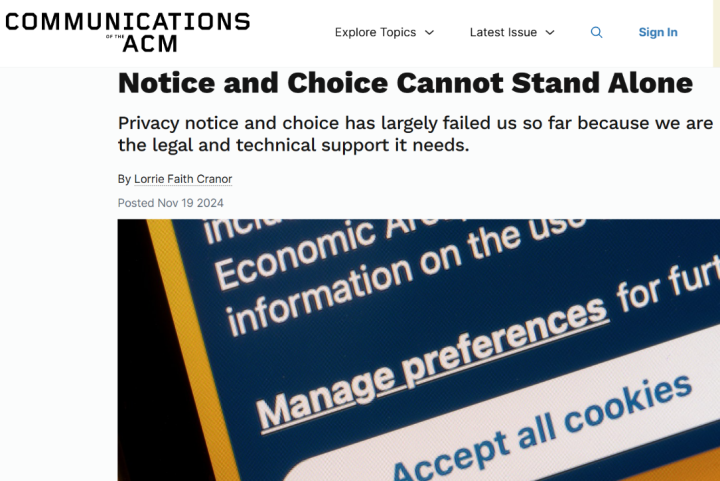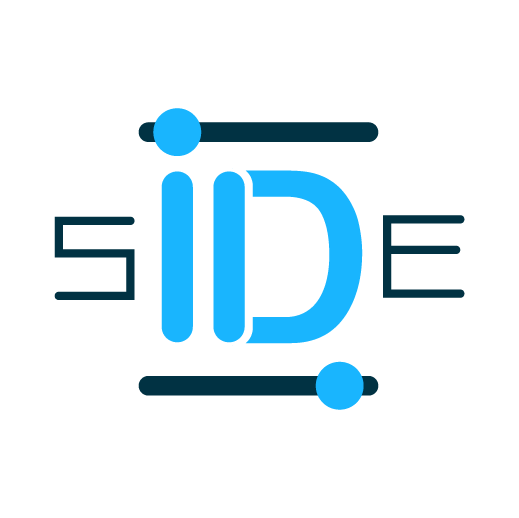US Academics get it right: 'Notice & Consent Cannot Stand Alone'
19 Nov 2024

Can we really consent online today? In a contribution released by Pr. Lorrie Cranor (Carnegie Mellon University) on 19 November 2024, it is stressed that, globally, “notice & consent” does not work "as is" and should be given “the legal and technical support it needs”.
As stressed in an IAPP contribution shared online by ID side Founder, Pr Cranor stresses that empowering individuals in practice is essential and should be done providing them with appropriate tech tools. From the binary approach of “Do not track” (DNT) to the current Global Privacy Control (GPC) developed in California (“which allows users to turn on a setting in their browser (or browser extension) that transmits a GPC signal to automatically opt out of websites selling or sharing their personal information”), she praises that “for the first time privacy laws are requiring websites to respect automated privacy signals such as GPC". Literally admitting California law sets a new cornerstone for regulating “valid consent” but, most of all, that a crucial landmark has been set to respect individuals’ right to share automated privacy signals and have those automatically complied with.
In practice, individuals should have the chance to seamlessly share their reasonable expectations online and switch from consent collection tools such as “Consent Management Platforms” (CMPs) to user-centric Privacy choices tools, such as ID side “Personal data choice management platform” (PDCMP). PDCMPs allow users to automatically share their by-default preferences regarding Privacy (i.e. by-default cookie choices) or commercial interests (i.e. agreement to be targeted by company C or sector (c) - and not A or (b) because they like Company C / sector (c) products or think that ads from Company C/sector (c) could be relevant to them) - see scheme below.
Indeed, our tool enables individuals to share their reasonable expectations, and to update those in few clicks, empowering everyone to take control over commercial processing and personalisation online. It addresses the real issue at stake: providing the tech tools individuals need to freely share their by-default choices and, so doing, streamline consent requests to a level compatible with human capacity to consent (a humanly manageable [available time / human capacity] ratio!).
As stressed in an IAPP contribution shared online by ID side Founder, Pr Cranor stresses that empowering individuals in practice is essential and should be done providing them with appropriate tech tools. From the binary approach of “Do not track” (DNT) to the current Global Privacy Control (GPC) developed in California (“which allows users to turn on a setting in their browser (or browser extension) that transmits a GPC signal to automatically opt out of websites selling or sharing their personal information”), she praises that “for the first time privacy laws are requiring websites to respect automated privacy signals such as GPC". Literally admitting California law sets a new cornerstone for regulating “valid consent” but, most of all, that a crucial landmark has been set to respect individuals’ right to share automated privacy signals and have those automatically complied with.
In practice, individuals should have the chance to seamlessly share their reasonable expectations online and switch from consent collection tools such as “Consent Management Platforms” (CMPs) to user-centric Privacy choices tools, such as ID side “Personal data choice management platform” (PDCMP). PDCMPs allow users to automatically share their by-default preferences regarding Privacy (i.e. by-default cookie choices) or commercial interests (i.e. agreement to be targeted by company C or sector (c) - and not A or (b) because they like Company C / sector (c) products or think that ads from Company C/sector (c) could be relevant to them) - see scheme below.
Indeed, our tool enables individuals to share their reasonable expectations, and to update those in few clicks, empowering everyone to take control over commercial processing and personalisation online. It addresses the real issue at stake: providing the tech tools individuals need to freely share their by-default choices and, so doing, streamline consent requests to a level compatible with human capacity to consent (a humanly manageable [available time / human capacity] ratio!).
